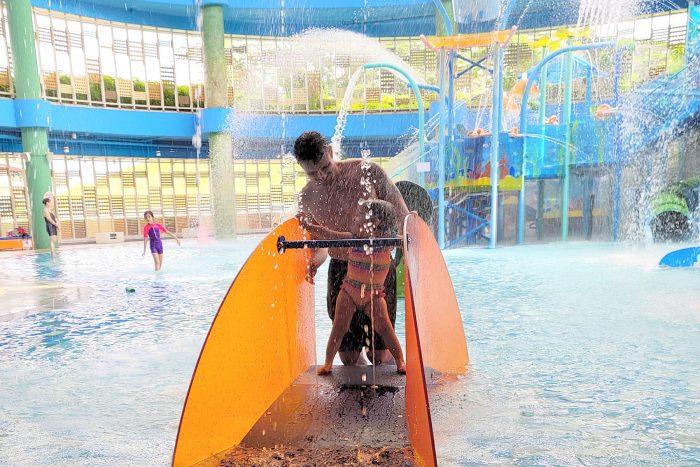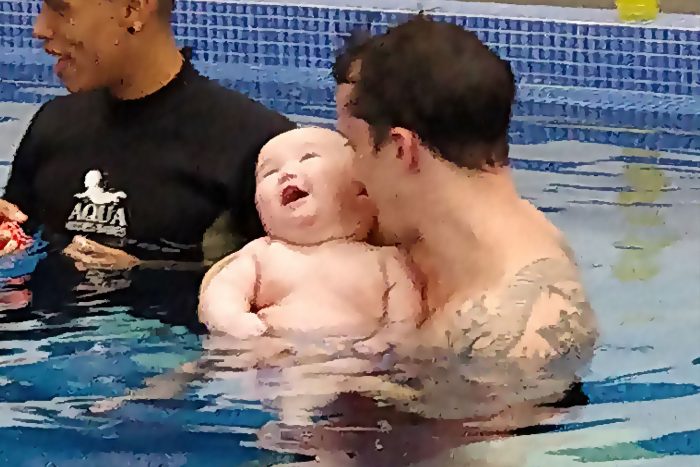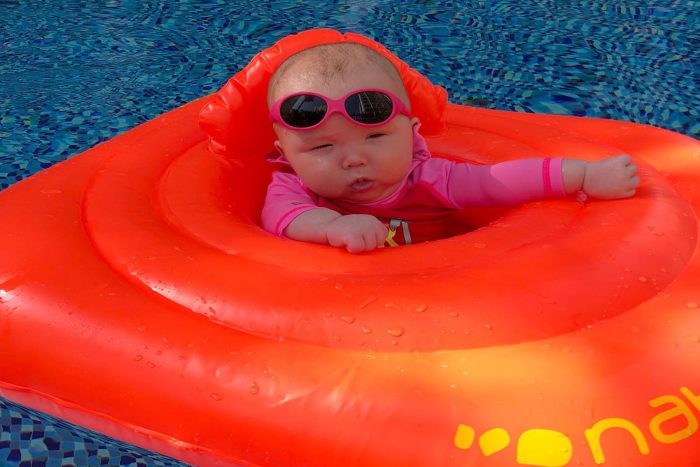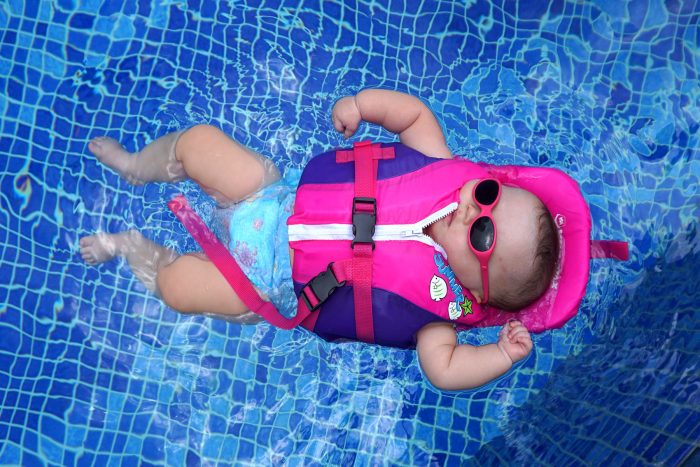How Water Therapy Has Benefited My Daughter With AADC
Written by |

Before my daughter, Rylae-Ann, showed symptoms of aromatic l-amino acid decarboxylase (AADC) deficiency, we had her in the ocean and the pool. I grew up on an island, where water activities were never far.
Water has many healing properties and benefits that helped our daughter make progress in addition to wonderful memories. Later, water activities became a more critical focus and were scheduled into our weekly routine after diagnosis.
Healing properties of water

In the water, Rylae-Ann is easily lifted and guided through movements. (Courtesy of Richard E. Poulin III)
Water creates an environment where we feel less heavy. This decreases the impact and strain on our children. It also makes it easier for us as caregivers, since we are supporting their weight and our own. Water is ideal for various activities. Pools with different depths allow for varying degrees of weight-bearing to support standing.
Sensory experience

Over time, Rylae-Ann had better sensory awareness and enjoyed water play. (Courtesy of Richard E. Poulin III)
Being in the water can be frightening at first for children. This new environment is filled with sensory stimuli, which can be a bit overwhelming for AADC children, as they often have trouble with sensory processing due to serotonin and dopamine deficiencies.
The water will provide input to every part of their body as they become submerged. This full-body sensation helps to establish body awareness. The immediate feedback of the water passing over their skin enhances their awareness.
Buoyancy is a whole other sensory experience. While buoyancy helps one perform exercises, it is a strange feeling that can take some getting used to. Being in the ocean or a saltwater pool will add additional buoyancy.
We generally use an indoor, saltwater pool, where water quality doesn’t pose any concerns and the environment is predictable. We have taken frequent trips to the beach because the additional sensory exposures to sand, wind, and sounds are equally important. Having adequate shade, plenty of water, and proper sun protection is crucial. Sunglasses are also important, as the bright light can be uncomfortable.
Hydrotherapy

A professional aqua therapy instructor delivers instructions while Daddy and Rylae-Ann listen happily. (Courtesy of Richard E. Poulin III)
Hydrotherapy, also referred to as aqua therapy, involves a trained professional. Warm pool water combined with hands-on techniques effectively support the body in learning movements that help increase muscle tone.
An aquatic therapist will customize exercises based on your child’s needs. We found that classes combining sensory, cognitive, and physical therapies are most beneficial.
If aqua therapy is not in the budget, or there are no licensed facilities in your area, you can still accomplish a lot by visiting a pool with family and friends. One important note is that public pools may not have the same maintenance and observation as private or commercial pools. Pool maintenance is necessary for ensuring that the water is at a pH level that will control algae and bacteria while still being safe and comfortable for our little ones.
Comfortable water

We slowly introduced Rylae-Ann to the water by building her confidence and comfort. (Courtesy of Richard E. Poulin III)
A heated pool made it easier for me to get in, as cold water isn’t motivating. More importantly, it’s more comfortable for our children. The facility staff will know the correct temperature, but obviously, we don’t want it too warm, either, since AADC children tend to run hot. It should be a soothing temperature that is ideal for physical activity and doesn’t cause overheating.
The International Swimming Federation, the organization that oversees international water sports, requires pool temperatures to be between 77 and 82.4 F (25-28 C), while most swim schools operate at a higher temperature. Warmer water combined with the buoyancy means we are able to stay in the water for longer.
Indoor pools

Rylae-Ann eventually found the water to be relaxing and soothing, and she enjoyed the feeling of floating. (Courtesy of Richard E. Poulin III)
Usually, we visit indoor pools. Sunlight helps us produce vitamin D and stay healthy, though we can give Rylae-Ann her daily dose of sunlight by visiting parks. Indoor pools offer protection from the sun and are always available, regardless of the weather.
Rylae-Ann learned to float on her back. This took time, but it helped when she could easily open her eyes and see my face above her. This reassured her that the funny, weightless feeling was normal, and that she could relax.
Saltwater pools

Twice a week, Daddy and Rylae visit an indoor heated saltwater pool for aqua therapy. (Courtesy of Richard E. Poulin III)
Since we visit the pool at least twice a week, a saltwater pool is preferable for our eyes, skin, and hair. Saltwater pools also lack a chemical smell, making it easier for our children to relax.
However, a properly maintained chlorine pool is just as safe and effective. Pools at condos or resorts we’ve stayed in were chlorinated, and we accomplished a lot there. Larger pools usually have different levels and layouts, providing more options for activities.
Although I prefer a saltwater pool, what’s most important is the quality of the water. Swimmers are at risk of developing respiratory infections from breathing in contaminated water, and aspiration and lung infection can be very serious for AADC children.
Water activities

Strategies and ideas from aqua therapy classes can be used when visiting the beach or the pool. (Courtesy of Richard E. Poulin III)
Weekly aqua therapy classes have given me several strategies and activities to work on at home or at the beach. I learn as much as Rylae does. First, we begin the activity with songs and get our children used to the water. Once they’re happy, we go through three different activities, focusing on sensory stimulation, physical movement, and then cognitive training.
The sensory activity usually involves pouring water on the body, and eventually, the head and face. Splashing water and bubbles are other favorites.
Physical activities are similar to what you’d see in a swim class. Ours also includes standing exercises.
Finally, the cognitive exercise requires children to complete a task in several steps. For example, I’ll help Rylae swim to a floating fish. She grabs the floating fish, and then we swim to the side of the pool and put it in the matching cup. Once all the cups are filled, we can pour them out.
All classes end how they begin — with a song and gentle dance. Ending on a happy note is vital in helping children return in a similar mood.
Joys of water play

Everyone in the family takes turns playing in the pool with Rylae-Ann. (Courtesy of Richard E. Poulin III)
Regardless of the activities or location, swimming can benefit children. The most important benefit for our family is the happy bonding experience. We can swim for the rest of our lives, so there’s no need to rush to make everyone comfortable. Begin with hands and toes before going all the way in. Take it step by step.
Although research about AADC deficiency and water therapy is not yet available, it exists for similar conditions, including cerebral palsy, developmental delay, sensory processing disorder, and general neurological disorders. Aquatic therapy, combined with additional physical and occupational therapy, has helped Rylae-Ann improve in multiple areas.
***
Note: AADC News is strictly a news and information website about the disease. It does not provide medical advice, diagnosis, or treatment. This content is not intended to be a substitute for professional medical advice, diagnosis, or treatment. Always seek the advice of your physician or other qualified health provider with any questions you may have regarding a medical condition. Never disregard professional medical advice or delay in seeking it because of something you have read on this website. The opinions expressed in this column are not those of AADC News or its parent company, Bionews, and are intended to spark discussion about issues pertaining to aromatic l-amino acid decarboxylase deficiency.







Leave a comment
Fill in the required fields to post. Your email address will not be published.